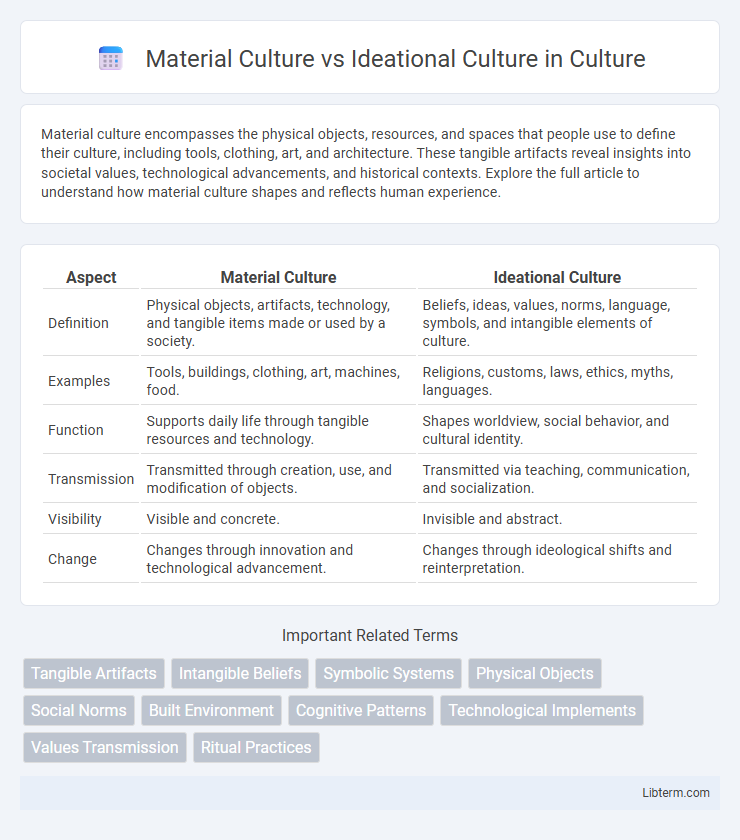Material culture encompasses the physical objects, resources, and spaces that people use to define their culture, including tools, clothing, art, and architecture. These tangible artifacts reveal insights into societal values, technological advancements, and historical contexts. Explore the full article to understand how material culture shapes and reflects human experience.
Table of Comparison
| Aspect | Material Culture | Ideational Culture |
|---|---|---|
| Definition | Physical objects, artifacts, technology, and tangible items made or used by a society. | Beliefs, ideas, values, norms, language, symbols, and intangible elements of culture. |
| Examples | Tools, buildings, clothing, art, machines, food. | Religions, customs, laws, ethics, myths, languages. |
| Function | Supports daily life through tangible resources and technology. | Shapes worldview, social behavior, and cultural identity. |
| Transmission | Transmitted through creation, use, and modification of objects. | Transmitted via teaching, communication, and socialization. |
| Visibility | Visible and concrete. | Invisible and abstract. |
| Change | Changes through innovation and technological advancement. | Changes through ideological shifts and reinterpretation. |
Defining Material Culture
Material culture refers to the physical objects, resources, and spaces that people use to define their culture, including artifacts, tools, buildings, and technology. It encompasses tangible items created, modified, or used by humans that reflect cultural values and social practices. Understanding material culture provides insight into historical contexts, technological advancements, and societal organization.
Understanding Ideational Culture
Ideational culture encompasses the intangible aspects of human life, including beliefs, values, norms, symbols, and rituals that shape social behavior and collective identity. It manifests through language, religion, art, and customs, reflecting the cognitive frameworks that guide interpersonal interactions and societal development. Understanding ideational culture requires analyzing these symbolic systems and meanings, which influence motivation, perception, and social cohesion beyond physical artifacts.
Key Differences Between Material and Ideational Culture
Material culture consists of physical objects, artifacts, and technology created and used by societies, reflecting tangible aspects of daily life and history. Ideational culture encompasses beliefs, values, symbols, and ideas that shape worldviews and social norms without physical form. The key differences lie in material culture's concrete, observable nature contrasted with ideational culture's abstract, conceptual influence on human behavior and cultural identity.
The Role of Objects in Material Culture
Objects in material culture serve as tangible representations of human beliefs, values, and social practices, enabling individuals to express identity and communicate culturally significant information. These artifacts influence daily life, social interactions, and the transmission of knowledge by embodying shared customs and traditions in physical form. The study of material culture reveals how objects shape and are shaped by economic systems, technological advances, and symbolic meanings within a society.
Beliefs and Values in Ideational Culture
Ideational culture centers on beliefs and values that shape a society's worldview, guiding moral judgments and social behavior. These intangible elements influence practices, rituals, and the interpretation of material culture, reflecting collective identity and meaning. Understanding ideational culture requires analyzing shared symbols, ideologies, and ethical norms that underpin group cohesion and individual purpose.
Interactions Between Material and Ideational Culture
Interactions between material culture and ideational culture reveal how physical objects embody beliefs and values within societies. Material culture, including artifacts and technology, serves as tangible expressions that transmit ideational culture such as customs, rituals, and symbolic meanings. This dynamic relationship shapes cultural identity and influences social behavior by reinforcing collective narratives through both concrete items and abstract ideas.
Influence on Social Behavior and Identity
Material culture shapes social behavior through physical objects and technology, influencing daily practices and community interactions by providing tangible symbols of status and group belonging. Ideational culture directs social behavior by transmitting beliefs, values, and norms that guide individuals' perceptions and actions within a society, deeply impacting collective identity and moral frameworks. The dynamic interplay between material artifacts and ideational meanings constructs social identity, as individuals express belonging through both external possessions and internalized cultural narratives.
Examples Across Different Societies
Material culture includes physical objects like tools, clothing, and architecture that reflect a society's technological advancement and environmental adaptation, such as the intricate pottery of the Ancestral Puebloans or the skyscrapers of modern cities like New York. Ideational culture encompasses beliefs, values, and symbols, illustrated by the caste system in India or the religious rituals of the Maasai in Kenya. Across societies, material culture often embodies ideational culture, as sacred symbols are inscribed on artifacts and monumental structures.
Implications for Cultural Change
Material culture, encompassing tangible objects like tools, clothing, and technology, often drives cultural change through innovations that reshape daily life and social interactions. Ideational culture, rooted in beliefs, values, and symbols, influences cultural change by altering collective worldviews and guiding behavior patterns over time. The dynamic interplay between material advancements and shifts in ideational frameworks accelerates cultural transformation and adaptation within societies.
Contemporary Debates in Cultural Studies
Material culture emphasizes physical objects and artifacts as key to understanding social practices, while ideational culture centers on beliefs, values, and symbolic meanings shaping human experience. Contemporary debates in cultural studies interrogate the interplay between materiality and ideology, questioning how power dynamics and globalization influence cultural production and identity formation. Scholars prioritize hybrid approaches that integrate tangible and intangible elements to better capture the complexities of cultural phenomena in a rapidly changing world.
Material Culture Infographic

 libterm.com
libterm.com